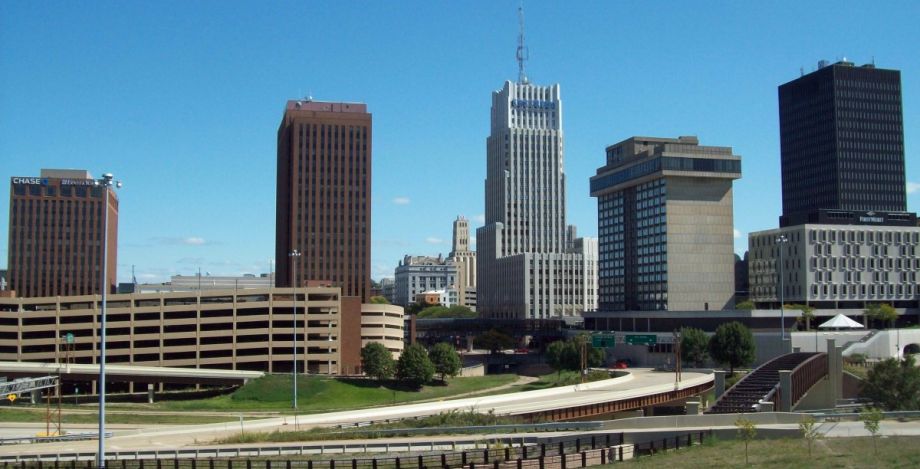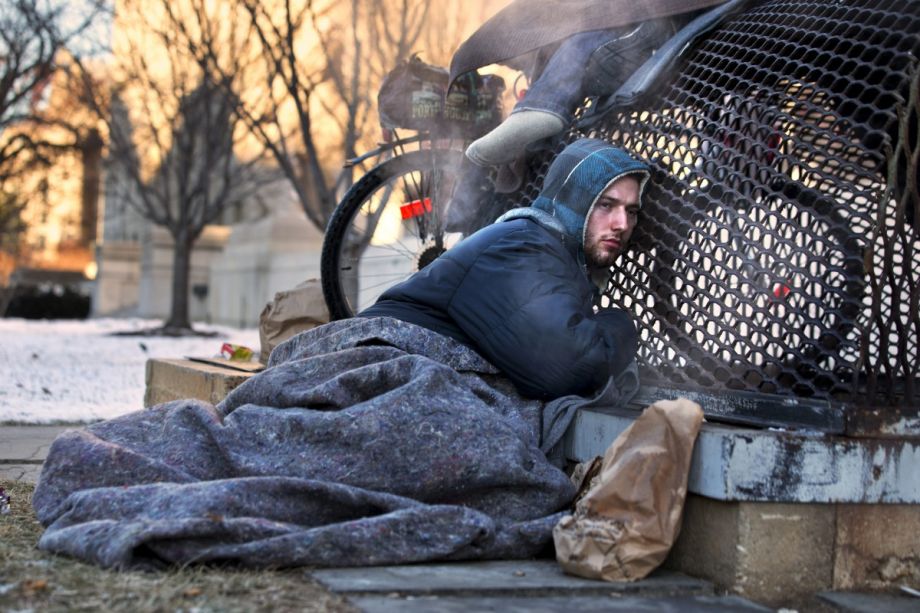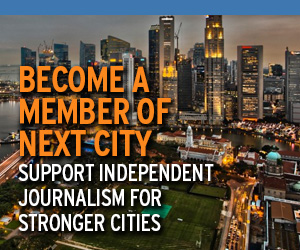Knight Cities Challenge Announces 32 Winners

Akron was one of the 26 communities included in the Knight Cities Challenge. (Photo by Sleepydre)
Count another funding boost for the tactical urbanism movement. The John S. and James L. Knight Foundation announced the winners of the first Knight Cities Challenge today — with money going to innovators who hope to make a big community impact with one creative idea.
The projects include a program to train Detroit rehabbers to combat blight and reactivate vacant buildings, a subscription service that celebrates Akron with a monthly boxed selection of local goods, a newcomer welcome initiative that would present St. Paul newcomers with a warm winter hat, and porch swings for Charlotte’s public spaces.
“Not only did the Knight Cities Challenge uncover a wealth of new ideas to make our cities more successful, it will help strengthen a network of civic innovators who are taking hold of the future of their cities,” said Carol Coletta, Knight Foundation vice president for community and national initiatives. “These important connections will help create a pipeline for new approaches to city transformation and spark the type of collaboration vital to growing and spreading good ideas.”
Thirty-two of the 126 proposed projects will share the $5 million prize to make their visions a reality. Participants ranged from individuals, government and nonprofit groups, all looking to improve one of 26 target communities.
From the press release, here are some of the winners, from seven of the Knight cities:
Akron
Better Block International Hostel on Airbnb, $155,000 by Team Better Block (submitted by Jason Roberts): Turning a vacant property into an Airbnb hostel and cultural hub in Akron’s North Hill to tap the entrepreneurial potential of the neighborhood’s growing Bhutanese population.
Unbox Akron, $52,168 (submitted by Chris Horne): Fostering a stronger connection to the city by creating a subscription service that celebrates Akron with a monthly selection of local goods and experiences delivered in a box.
Charlotte
No Barriers Project, $67,100 (submitted by Sarah Hazel): Bringing two diverse neighborhoods together in a public park that sits on their border by creating a new common space that uses light, sound and play to stimulate conversation.
“Porch” Swings in Public Places, $28,000 (submitted by Tom Warshauer): Fostering conversation among strangers by installing Charlotte’s signature porch swings in public spaces.
Take Ten Initiative, $74,000 (submitted by Alyssa Dodd): Challenging municipal workers to take 10 minutes each week to connect with a city resident and report on their thoughts and ideas.
Detroit
Brand Camp: Detroit’s Neighborhood Initiative, The RE-Effect, $164,810 by Brand Camp University (submitted by Hajj Flemings): Changing the narrative of underserved neighborhoods by developing compelling branding and digital presences for neighborhood businesses that better tell their stories.
Brick + Beam Detroit, $87,424 by Michigan Historic Preservation Network (submitted by Emilie Evans): Creating a new community of Detroit rehabbers who will work together to combat blight, reactivate vacant buildings and improve their city.
The Buzz, $84,055 by Detroit Future City (submitted by Erin Kelly): Pairing barbers with landscape contractors to transform overgrown vacant lots through facilitated design workshops that teach mowing and pattern-making techniques.
Detroit Homecoming, $100,000 by Crain’s Detroit Business (submitted by Eric Cedo): Engaging Detroit expats with a new digital community designed to keep them connected to Detroit and its opportunities.
LIVE Detroit, $40,000 by LIVE Detroit (submitted by Rachel Perschetz): Attracting and retaining residents by creating a center for information about Detroit neighborhoods and city life that showcases the best of Detroit.
Miami
The Science Barge, $298,633 by CappSci (submitted by Nathalie Manzano-Smith): Creating a public focal point for Miami’s climate issues with the Science Barge, a floating, urban sustainable farm and environmental education center powered by renewable energy.
Philadelphia
The Pop-Up Pool Project, $297,000 by Group Melvin Design (submitted by Benjamin Bryant): Introducing fun, easy solutions at city pools, which will be designed to make them more vibrant places to meet and interact with neighbors and friends.
South Philly’s Stoop, $146,960 by Scout (submitted by Lindsey Scannapieco): Transforming the vacant space surrounding the recently closed, historic Edward Bok school in South Philadelphia into a new community living room that brings community members together, encourages connections and engages people with neighborhood history.
Urban Arboreta, $65,000 by City Parks Association of Philadelphia (submitted by Timothy Baird): Transforming vacant land in Philadelphia into urban forests that produce trees to be replanted on city streets and in parks.
Next Stop: Democracy! The Voting Signage Project, $166,394 by Here’s My Chance (submitted by Lansie Sylvia): Making voting in local elections more enticing by creating new types of signs at polling places and commissioning artists to perform site-specific pieces on election days.
Neighborhood Conservation Kit, $20,000 by Central Roxborough Civic Association (submitted by Sandy Sorlien): Putting the future of communities in residents’ hands with a toolkit they can use to create a special zoning designation called a Neighborhood Conservation Overlay.
Philadelphia Immigrant Innovation Hub, $261,500 by Mt. Airy USA (submitted by Anuj Gupta): Harnessing the talent and energy of immigrants to revitalize distressed neighborhoods by providing centers that would offer immigrant entrepreneurs low-cost space, language assistance, workshops and trainings, and access to traditional and non-traditional sources of capital.
DIG Philly by The Big SandBox Inc., $149,050 (submitted by Jacques Gaffigan): Bringing together members of the community from diverse ages, ethnic and economic groups to create a movement to reinvent schoolyards across the city using traditional grassroots outreach and new digital engagement tools.
San Jose
Houslets, $40,000 by Houslets (submitted by Tim McCormick): Prototyping and deploying low-cost, modular housing and workspace units to test a new model for temporary and affordable housing for San Jose’s fast-growing population.
San Pedro Squared, $139,000 by San Jose Downtown Association (submitted by Scott Knies): Testing a new method of economic revival focused on bringing activity to the streets by installing pop-up retail units on the ground floor of a parking structure opposite the lively San Pedro Square market.
St Paul, Minnesota
4 Play, $117,000 by Greater MSP (submitted by Peter Frosch): Changing the way people perceive the city and its climate by inviting all residents to come together for an outdoor activity—whether it’s ice fishing or summer canoeing—once per season.
8-80 Vitality Fellow, $175,000 by Mayor’s Office, City of St. Paul (submitted by Mayor Chris Coleman): Promoting a more livable St. Paul by embedding a fellow in the mayor’s office who will work across departments to manage the $42 million committed to the mayor’s 8-80 Vitality Fund, which aims to ensure that walking, biking and public spaces are a priority in all city projects.
MN Nice Breakers, $37,960 (submitted by Jun-Li Wang): Making the city more welcoming by using existing events to help newcomers quickly establish social networks that attach them to the city.
Rolling Out the Warm Welcome Hat, $67,288 (submitted by Jun-Li Wang): Welcoming newcomers by having city leaders hold monthly ceremonies to give them an official welcome gift, a warm hat for Minnesota winters.
You can find the complete list of winners here.
Jenn Stanley is a freelance journalist, essayist and independent producer living in Chicago. She has an M.S. from the Medill School of Journalism at Northwestern University.
What a Massive Indian Festival Can Teach Us About Improving Cities

Devotees gathered for the Kumbh Mela bathing festival in Allahabad in 2013. MIT Media Lab researchers see the festival as an opportunity to study pop-up cities and rapid urbanization. (AP Photo /Manish Swarup)
India’s orange-robed godmen are rarely the focus of urban planners. But later this year, 40 million religious pilgrims are expected to descend upon Nashik — a rapidly growing city a few hours from Mumbai — and, almost overnight, swell the modest metro into the largest city in the world.
The 20-day Hindu festival, the Kumbh Mela, can attract crowds the size of multiple New York Cities on a single day. The religious event takes place every three years when devotees make the trek to one of four alternating cities — Allahabad, Nashik, Hardiwar or Ujjain — to bathe in one of the sacred rivers. While the spiritual seek to cleanse themselves of sin, urban innovators, policymakers and planners see the population surge as an ideal opportunity to gather data and test new ideas related to pop-up cities and rapid urbanization.
“It’s a perfect set of problems,” says Daniel Goodman, a graduate student in the MIT Media Lab, which helped organize a weeklong “innovation sandbox” called the Kumbhathon in Nashik earlier this year. “The Kumbh Mela doesn’t last very long, but during that time it stresses the city on all fronts. It forces us to think about fundamental problems, such as sanitation, food distribution and good utilities.”
The Kumbhathon, which was conceptualized by Nashik-based innovator Sunil Khabdbahale and Ramesh Raskar, head of Camera Culture Group at the MIT Media Lab, set out to understand the challenges faced by host cities of the Kumbh Mela and experiment with technologically focused interventions. The group received more than 500 responses on its open, crowdsourced platform that asked the public to identify key areas of concern. Organizers whittled that long list down to 12 target themes that included health, housing, food, payments and transportation.
Understanding the challenges was just the beginning. In January 2015, the Kumbhathon brought together innovators from 20 cities across India to get creative with tackling the issues at hand. Participants came from a broad range of fields — from computer science to mechanical engineering to business and public health — and gathered in Nashik for a week to look more closely at the city, its current and future challenges and brainstorm on best ways to intervene in better managing the soon-to-be megacity. MIT faculty, entrepreneurs and industry experts acted as mentors to the groups, and local experts from Nashik challenged their ideas with personal experiences and knowledge of the current urban landscape. The ideas were also evaluated by technical innovators for deployment, marketability and scalability.
Nashik is an ideal city to study and test the stresses of urbanization and what can be done to prepare for it. The city is the 16th-fastest growing metropolis in the world and one of the fastest growing in India. The Kumbh Mela will send that growth into overdrive for a few weeks. Nashik has also been selected as one of Prime Minister Narendra Modi’s “100 Smart Cities,” an initiative launched last year to drive forward technology in urban development around India.
While India’s megacities such as Mumbai and Delhi capture most superlatives, architect Rahul Mehrotra, chair of Harvard’s Department of Urban Planning and Design, has been urging policymakers and planners to look beyond the major metropolises to the emerging metros such as Nashik. In an article in the Hindu in 2011, he said, “Furthermore, it is crucial for us as a nation to focus on our small towns and tier two cities; these will comprise a vast majority of the urban Indian population in the future. These are also places (unlike the megacities and primary towns) that are not locked into unsustainable paradigms and where planners still have possible ways of intervening.”
One of the ideas for intervening devised by Kumbhathon participants is an epidemic tracker. Major public health crises, particularly in the wake of the Ebola outbreak, have brought new challenges to developing world cities. Like the Kumbh Mela, these cities often lack accurate data on crowded informal settlements, where disease can spread quickly, making it difficult to react in case of an event. The epidemic tracker monitors the health status of people in real time to check and control disease outbreaks. Up-to-the-minute information could enable medical staff to identify individuals with threatening symptoms and quickly provide them with the necessary care to prevent further infection.
Another major logistical challenge during the Kumbh Mela is food distribution. The Kumbhathon participants devised a system that connects festival-goers with quality food suppliers. “Such a model could bolster the Indian food industry and potentially translate into a multibillion-dollar service across India that caters to the lower-income population,” according to one Kumbhathon report. The issue, it said, is that customers have to make risky food transactions, because they often have little or no information about when the food was cooked, who cooked it or the rating of the person who cooked it. Information linkages such as these enhance the experience, safety and running of pop-up cities.
But, urge Kumbhathon organizers, the potential of these innovations go beyond this one event. “This is not just to help the Kumbh Mela,” says Kumbathon co-founder Khabdbahale. “This is about promoting innovation in cities like Nashik. We have a big opportunity here to test ideas for city optimization around India.”
The Science of Cities column is made possible with the support of the John D. and Catherine T. MacArthur Foundation.

Carlin Carr is the founding editor of Megapolis India and an editor at Women in Informal Employment Globalizing and Organizing (WIEGO).
Cities Are Hiring This Controversial Homelessness Consultant

(AP Photo/Jacquelyn Martin)
Strategies to end homelessness in cities vary wildly. Some municipalities lean tocriminalization — cracking down on tent cities or banning panhandling in downtowns. Others embrace the housing first model, helping people into more permanent living situations in an attempt to avoid the cycle of on-and-off shelter life.
Robert Marbut is a homelessness consultant who criss-crosses the country positing an alternative model. For each city that hires him, he provides a custom plan, which often includes large-scale shelters (he advocates for the term “transformational campuses”) with onsite treatment facilities for underlying issues. He is the founding president of San Antonio’s Haven for Hope — the country’s largest campus of its kind. The complex sits on 37 acres of land, houses 78 nonprofit service organizations and has the capacity for 1,600 individuals on any given night.
Marbut has had his share of criticism. Many see his reward-and-punishment-based seven guiding principles from enablement to engagement as too harsh, and many also feel that the facilities he recommends keep urban homelessness problems hidden from public view. He’s also been a vocal opponent of food distribution programs, saying to myself and others, “Don’t mix the hunger issues of America with the homeless issues of America.” A recent Huffington Post article titled “How a Traveling Consultant Helps America Hide the Homeless,” tells a tale of Marbut in “homeless disguise” in Daytona Beach, “so he could embed with Daytona’s homeless people in order to understand their struggle to survive, if only for a few days.”
Whatever you think of his approach, cities are hiring him. His recent client list includes Fresno, California, and St. Petersburg and Pensacola, Florida.
I asked Marbut about some of his controversial views, his six-figure fees and how he thinks President Obama’s homelessness initiatives have been progressing.
What are some of the qualities shared by cities you think are the most successful at tackling homelessness?
The most important thing in successfully addressing homelessness is dealing with the root causes. The core causes of male homelessness are behavioral/mental health, substance abuse and job retention. When you get to females, you also have to add domestic violence. The cities that successfully address this say, ‘We’re going to figure out how to do this regardless of the federal government, regardless of state government, and we’re not going to wait for Santa Claus to come around to help us.’
The most important thing in successfully addressing homelessness is dealing with the root causes. The core causes of male homelessness are behavioral/mental health, substance abuse and job retention. When you get to females, you also have to add domestic violence. The cities that successfully address this say, ‘We’re going to figure out how to do this regardless of the federal government, regardless of state government, and we’re not going to wait for Santa Claus to come around to help us.’
The cities that don’t do well come in two flavors: Do nothing or NIMBYism. Do nothing can range from saying, ‘It’s not the government’s role,’ or being overwhelmed. Generally the biggest problem I see is NIMBYism.
Some end up doing a lot of gimmicky things that simply will not work in the long run. You might get a temporary bounce for two or three days or a week or two. That includes the criminalization. If you use ordinances to criminalize and you do not provide alternative services, you do not provide correct engagement. Those gimmicks don’t work. They make you feel good for an hour.

In the recent Huffington Post profileof your work, you were seen as being critical of the “housing first” model. Where do you see housing fitting in with your work?
If you look at any of the reports that I’ve ever written, for most communities, I give seven, eight or nine recommendations, of which one is sometimes a transformational center. [It is] a central service hub where you run activities, which deals with root causes. Then, you deal with supportive housing. Sometimes people call that housing first.
If you look at any of the reports that I’ve ever written, for most communities, I give seven, eight or nine recommendations, of which one is sometimes a transformational center. [It is] a central service hub where you run activities, which deals with root causes. Then, you deal with supportive housing. Sometimes people call that housing first.
You need to develop a series of services that address different points of recovery if you really want to be successful. You can’t just build one phase. You can’t just build emergency services and not build supportive housing and vice versa. The really good places that do it well have an integrated system.
Are you recommending different strategies now than you did in the past?
We’ve gotten smarter in realizing that some solutions will work with a subset of individuals experiencing homelessness [and not others]. There’s sort of a one-size-fits-all mentality at the federal government level, which I find disconcerting. On the front line or on the ground, what you find that works for a veteran with post-traumatic stress is different than a single mom [affected by] domestic violence. The mom, in that case, is looking for security more than anything. The post-traumatic stress individual really needs mental health and behavioral services. They may be self-medicating in order to go to sleep at night. You have to customize those treatments not just by a group of individuals, but by the individual.
We’ve gotten smarter in realizing that some solutions will work with a subset of individuals experiencing homelessness [and not others]. There’s sort of a one-size-fits-all mentality at the federal government level, which I find disconcerting. On the front line or on the ground, what you find that works for a veteran with post-traumatic stress is different than a single mom [affected by] domestic violence. The mom, in that case, is looking for security more than anything. The post-traumatic stress individual really needs mental health and behavioral services. They may be self-medicating in order to go to sleep at night. You have to customize those treatments not just by a group of individuals, but by the individual.
I’m pretty controversial, because I often say, ‘Having a home is not the problem for the homeless. It’s maintaining a financial stability that allows you to maintain your homestead.’ Don’t mix the hunger issues of America with the homeless issues of America. It’s really important if you want to address what the root cause issues of homelessness are, it’s not about food or t-shirts or suntan lotion.
How do you feel when people are critical of you as an outside consultant coming into cities, especially with your associated fees?
If there’s a major foundation who wants to pick up our travel and other costs — and do it so I could do it for free for anyone — I’d love that. I do this as my mission in life, but you have to pay for the flights and computers … I also do tons of pro bono work. I can’t afford to physically go to every city pro bono, but I do it through Skype and I was doing that just yesterday.
If there’s a major foundation who wants to pick up our travel and other costs — and do it so I could do it for free for anyone — I’d love that. I do this as my mission in life, but you have to pay for the flights and computers … I also do tons of pro bono work. I can’t afford to physically go to every city pro bono, but I do it through Skype and I was doing that just yesterday.
Secondly, the advantage of a consultant … is that I’ve been involved in a professional level in well over 100 cities. I’ve been to 694 cities as of last week. I’ve seen a lot that works and I’ve seen a lot that doesn’t work. Why would you want to replicate the mistakes made in other cities instead of working on national best practices?
How effective do you think the Obama administration’s strategy to end homelessness has been?
It has not been effective. Back in Bush times, there was a 10-year plan to end homelessness. It’s expired and I don’t know anywhere in the United States that’s eliminated homelessness. So when Obama comes and asks for a five-year plan, we’re now five years plus one on that five-year plan and how are we doing?
It has not been effective. Back in Bush times, there was a 10-year plan to end homelessness. It’s expired and I don’t know anywhere in the United States that’s eliminated homelessness. So when Obama comes and asks for a five-year plan, we’re now five years plus one on that five-year plan and how are we doing?
I think the federal government needs to be a lot more practical about what really works in the field … . You need to have a sophisticated understanding of the triggers of homelessness. I know I get a lot of people mad at me when I talk like this, but it’s my passion and I truly believe in it.
This interview has been edited for length and clarity.
The Equity Factor is made possible with the support of the Surdna Foundation.

Alexis Stephens is Next City’s urban economics fellow. She’s written about housing, pop culture, global music subcultures, and more for publications like Shelterforce, Rolling Stone, SPIN, and MTV Iggy. She has a B.A. in urban studies from Barnard College and an M.S. in historic preservation from the University of Pennsylvania.




No comments:
Post a Comment
Please leave a comment-- or suggestions, particularly of topics and places you'd like to see covered